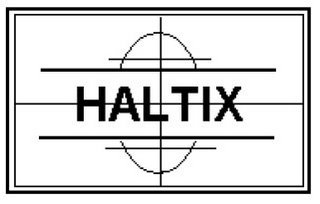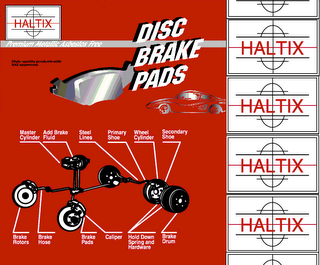TTAB Sustains 2(d) "HALTIX & Design" Opposition, But Puts the Brakes on Fraud Claim
Pro se Applicant Adam Zikry lost a 2(d) opposition to registration of his mark HALTIX & Design (shown immediately below) for automotive brake pads, but the Board did give him a "brake" on the fraud issue. The Board found the mark likely to cause confusion with the registered marks HALDEX and HALDEX EB+ for automatic brake adjusting equipment, vehicle brake parts, and other brake-related goods. Haldex Brake Corp. v. Zikry, Opposition No. 91160715 (September 5, 2006) [not citable].

Applicant Zikry did not submit evidence or file a brief. Opposer Haldex relied on it registrations and on Zikry's discovery deposition testimony and his responses to interrogatories.
Starting with the HALDEX registration, the Board found the marks HALTIX & Design and HALDEX to be "somewhat alike in overall appearance with no discernible difference in connotation." Also, they are "nearly identical in sound and commercial impression." Therefore, the first du Pont factor favored Opposer.
As to the goods, the Board read Applicant's identification of goods to include sales to original equipment manufacturers of automobiles (despite the indication at his website that he sold to the aftermarket), but not to include brake parts for use on large land vehicles. The goods in the HALDEX registration related to air braking systems, which are used on large trucks and buses. The Board was not sure that the involved goods move in the same channels of trade, but it nonetheless found an overlap in customers:
"The population most susceptible to confusion would be fleet owners and mechanics for commercial buses, trucks and trailers, who might well also service their own personal automobiles. Hence, all of Haldex Brake's customers are prospective consumers of applicant's goods."

Turning to the HALDEX EB+ registration, its "brake disks, brake shoes, brake cylinders, friction pads" were not limited as to type of vehicle, and they presumably could be "substantially identical to applicant's named goods and might move in the same, or very similar, channels of trade, where they would be available to all potential customers.
The marks HALTIX & Design and HALDEX EB+, according to the Board, convey a similar commercial impression and, when compared in their entireties, are confusingly similar.
The Board therefore sustained the opposition on the Section 2(d) ground.
With regard to Opposers' fraud claim -- based on the false statement in Zikry's application that he had used his mark in commerce -- the Board showed some leniency toward this Applicant. It recognized that Zikry "has tried repeatedly to break into the U.S. market," but substantially all the goods he has sold to date have been shipped directly from China to his cousins' business in Cairo, Egypt.
"... while it appears as if this pro se applicant has not been met with a great deal of success in marketing his brake pads in the USA, given his active attempts to create a market here, including his supplying prototypes to parts retailers in locations such as Tampa, Florida, and Washington, DC, his ongoing presence on the Internet, and his meaningful volume of sales in international commerce, we find that applicant may well have been unaware of the technical requirements for an allegation of 'use in commerce' under the Lanham Act, and that accordingly, opposers have failed to meet their burden of proving by clear and convincing evidence that applicant has made a false representation of a material fact with knowledge of the falsity of the statement."
TTABlog comment: For a refresher course on fraud, see the TTAB Fraud Collection. This case seems most like the citable Maids to Order of Ohio, Inc. v. Maid-to-Order, Inc., 78 USPQ2d 1899 (TTAB 2006), in which the Board rejected Petitioner's fraud claim. Petitioner contended that Respondent had committed fraud by falsely claiming use of its mark MAID TO ORDER in interstate commerce. But the Board concluded that Petitioner failed to meet its "“heavy burden" to prove fraud: "“It was not unreasonable for Ms. Kern, as a layperson, to believe that [Respondent'’s] activities constituted use of the MAID TO ORDER mark in interstate commerce. *** This belief is sufficient to negate an inference of fraud upon the USPTO in obtaining and maintaining the registration."” [In other words, the question of whether the mark was used in interstate commerce leaves room for error; the question of whether a mark has been used at all, however, is black-and-white.]
Text Copyright John L. Welch 2006.




0 Comments:
Post a Comment
<< Home